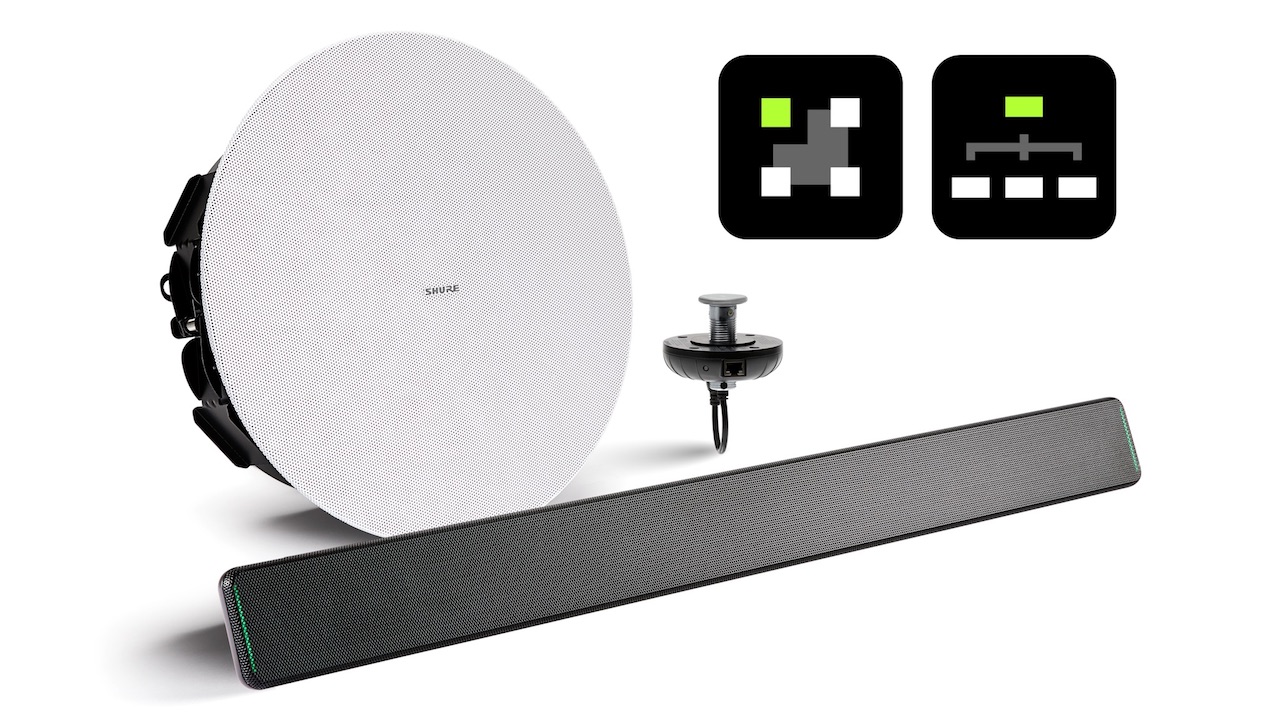Product Review: Shure Conferencing Audio Ecosystem

As software-based conferencing continues to march forward, the pro AV industry has been busily developing solutions to get the most out of the flexibility these communications platforms afford. With the trend—accelerated by the pandemic—pushing videoconferencing into more and more spaces to accommodate distributed work teams, the simplicity of these AV tools is paramount. Simply put, organizations need simple solutions that are easy to install and convenient to manage.
This was the inspiration between two new offerings from Shure that are designed to form the audio core for conferencing spaces in today’s world: the MXA710 and MXN5-C. The MXA710 linear array microphone is essentially a long, slender version of the company’s MXA910 ceiling array mic, and utilizes Shure’s Patented Steerable Coverage technology to intelligently capture audio throughout a space. The MXN5-C is a PoE-equipped, low-profile ceiling speaker that is deployed and controlled via software, and does not require a separate amp or outboard DSP. Both products are engineered to work seamlessly with each other and with the company’s full line of networked hardware and software solutions. So just how easy is it to deploy a professional-quality conferencing system with Shure’s latest products?
First Impressions
As a technology manager, I’m always looking for new solutions that will make my job more comfortable and improve my users’ experience. The system shipped to me in two boxes, one containing the Shure Microflex MXA710-4FT linear array microphone, and the other with the MXN5-C loudspeaker and a P300 Audio conferencing processor. The MXA710 included a mounting bracket and the user guide; the MXN5-C loudspeaker contained the user guide, construction bracket, speaker, and a magnetic speaker cover that can be painted. The P300 came with a mounting bracket and videoconference kit including input/output connectors. All the equipment was very straightforward and intuitive to set up right out of the box.
I currently use Shure handheld wired and wireless microphones in classroom and event spaces at my institution and I also have experience using Dante enabled devices, so I found the experience of getting up and running with the system intuitive and familiar.
Setting Up the System
Assembling the MXN5-C loudspeaker to the construction bracket was very easy, as all you have to do is tighten the screws. The speaker has built-in butterfly clips that clamp on to the frames, allowing you to adjust it to varying ceiling tiles. The MXA710 mounting bracket was just as easy to set up. The MXA710 is also equipped with automatic mixing, acoustic echo cancellation, noise reduction, and automatic gain. The speaker, microphone array, and the P300 connect using a standard Cat-5 or better cable and are powered by PoE or PoE+ in a standard gigabit switch.
Some noteworthy features include the Shure web device discovery tool, an easy way to gather device information such as IP address, control and Dante Mac addresses, and other simple configurations like mute/unmute. This discovery tool can be password protected for an extra level of security.

Shure Designer software that can be downloaded directly from Shure's website after signing up for a free account gives you the ability to configure devices in virtual mode or live mode. Virtual mode provides you the opportunity to combine the tools and simulate the proper room configuration. Also, using the virtual mode will allow the user to determine the amount of equipment needed for a specific space. With the devices online using the live mode, you can configure them in real-time, which I found to be very efficient. You can also automatically optimize the devices for the best sound quality.
A daily selection of features, industry news, and analysis for tech managers. Sign up below.
A feature I feel is missing and should be considered is the capability for a passive connection to other loudspeakers. However, the fact that the loudspeaker has a direct link gives the user more control, security, and configuration options.
The MXA710 can be mounted horizontally on a wall like a soundbar or be suspended from the ceiling, providing extra versatility for different spaces. Also, it allows the user to configure up to eight virtual lobes. These eight lobes can be configured individually, or you can set them to IntelliMix. As part of the P300 audio conferencing processor, IntelliMix allows auto configuration and tunes to the best sound quality. Additionally, the PoE/PoE+ eliminates the need for an outboard amplifier, and Shure offers audio encryption that can be configured for these products.
The MXN5-C loudspeaker also has configuration options such as adjusting gain, setting delays, limiter, and signal/tone generator.
Overall, the devices present a slick, low-profile appearance that blends well into the environment. The indicator on the MXA710 quickly shows you when the microphone is live or muted. All devices also include built-in wire management, which is ideal for keeping a mess-free organized meeting space.
Testing it Out
I began testing the devices using Chrome devices, Windows PCs, and Apple laptops. I found the devices operated well on all platforms. The only requirement was to select the proper conferencing devices in the software settings. I tested with Google Meet and Zoom on all the devices. Although these Shure products are not certified for Google Meet (they are certified for Zoom and Microsoft Teams—with the exception of the MXA710, which is in process of being certified, and MXN5C for Zoom, which is also in process for certification), everything worked properly. The only downside was that the mute indicator did not reflect when you were muted. As for Zoom, the product operated as expected. The indicators on the MXA710 displayed green when live and red when muted.
To get an idea of the sound quality, I tested the products in two different locations. In the first location, a rectangular conference room, I stood approximately 18 feet away from the microphone. Although the room is located near egress, the sound quality was super clear and crisp. I did not experience any issues being heard, and I could speak in a normal tone. I did not feel like I had to raise my voice at any point, even while I walked around the room.
The second location was slightly smaller—a square room with windows—and the microphone was situated approximately 12 feet away from where I was sitting. As in the first location, the sound quality was solid, consistently clear and intelligible. The sound optimization was excellent as I did not experience a difference in quality despite both locations' acoustic challenges.
Worth noting was that when transporting the equipment from one location to another, the breakdown and setup did not take more than 30 minutes, and I was able to do it all on my own.
The Verdict
Overall, I was pleasantly surprised by how much I enjoyed using these products. As a person who has multiple virtual meetings daily, I enjoyed the freedom of not having to continually wear headphones without compromising sound quality and the overall functionality. As we transition into more collaborative virtual environments, using technology that does not feel intrusive with an ease-of-use component will only increase value and become a necessary resource. Therefore, it is with great pleasure that I recommend these products to be used in any size conference area as they provide the scalability to conform to any setting. Shure has developed excellent products and continues to live up to its reputation of providing consumers with superior audio equipment.
Emil Delgado is the director of client services at St. Peter’s University in Jersey City, NJ.
Emil Delgado is the director of client services at St. Peter’s University in Jersey City, NJ.
